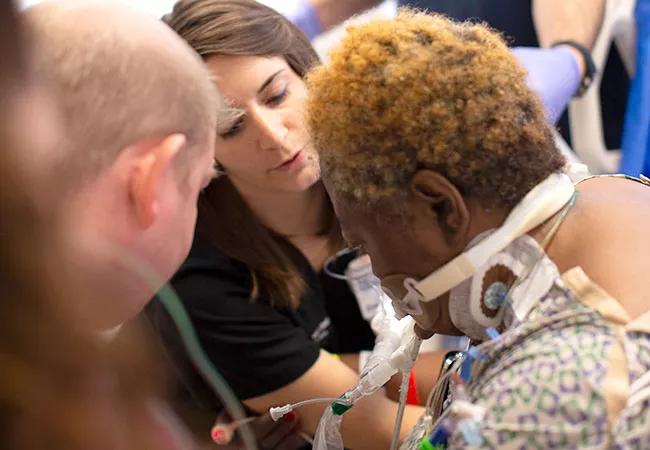As neuro ICU survival improves, long-term effects demand attention

Approximately 6 million critically ill patients are admitted to all types of intensive care units (ICUs) in the U.S. annually, and about 5 million now survive. “While this is a tremendous advance, survival can lead to deficits in cognition and mental and physical health that persist for months and even years,” observes Joao Gomes, MD, Head of the Neurointensive Care Unit in Cleveland Clinic’s Cerebrovascular Center.
Advertisement
Cleveland Clinic is a non-profit academic medical center. Advertising on our site helps support our mission. We do not endorse non-Cleveland Clinic products or services. Policy
Increased recognition of such deficits — known as post-ICU syndrome (PICS) — has led to parallel recognition that ICU survival “shouldn’t be the be-all and end-all of treatment,” Dr. Gomes notes. “We have to focus on improving quality of life and ability to return to work almost as much as surviving the initial injury or illness.” He adds that it’s now recognized that families and caregivers, like patients, may also experience anxiety, depression and post-traumatic stress disorder (PTSD) as a result of seeing loved ones in critical condition, and their needs must also be addressed.
To date, most of the research on PICS has taken place in medical and general/surgical ICUs. “To gather data specific to the neurointensive care unit, we have begun research efforts to explore neuro PICS at Cleveland Clinic,” Dr. Gomes says.
An initial study has been conducted to evaluate patient and family experiences in the neuro ICU, and baseline data have been compiled using a validated tool. “Next we’ll be implementing strategies proposed by the Society of Critical Care Medicine to determine whether there are ways to improve caregiver experience,” he adds.
Because of the nature of brain injuries sustained by neuro ICU patients, Dr. Gomes notes, these patients appear to be more susceptible to PICS than are general ICU patients. He cites a few examples:
Advertisement
No formal guidelines for the prevention or management of PICS currently exist. Dr. Gomes says Cleveland Clinic is using the ABCDEF bundle intervention developed by the Society of Critical Care Medicine to improve ICU outcomes and potentially prevent or ameliorate PICS. The intervention consists of:
Use of an ICU diary or journal has also gained traction, as studies show the technique is effective in reducing the incidence of PTSD in this population. “The idea is for clinicians to keep a daily journal for patients, writing about things that occurred during their ICU stay to help them recall the experience,” Dr. Gomes explains. “An entry may cover the day they awoke from a coma or had their breathing tube removed, and how they reacted. Patients often have impaired recollection of their ICU stay and may have trouble distinguishing reality from hallucinations while seriously ill, which can occur as the mind tries to make sense of what’s happening.”
Advertisement
Moreover, waking with a breathing tube or restraints in place can prove extremely anxiety-provoking and even lead to PTSD, especially if patients don’t know how they got where they are. “Some patients have told us they thought they were being assaulted or kidnapped while in the ICU,” Dr. Gomes reports.
A high index of suspicion for PICS should be paramount in interactions with patients following a neuro ICU stay, Dr. Gomes advises, even three to six months after discharge. “Eventually we would like to create a post-ICU clinic at Cleveland Clinic, for doing formal assessments for PICS and offering physical therapy and psychiatric and cognitive treatments,” he says. Such a clinic also could allow patients to discuss their ICU stay and help them process the experience and its aftermath.
He notes that while recognition of PICS is improving, it remains a largely unrecognized syndrome. “The focus is still on the acute illness, which certainly is critical, but we also have to consider what happens to these patients and their families after discharge,” he says. “These individuals are sometimes referred to in the literature as the ‘walking injured’ — they seem to be okay after surviving a major illness or injury, but they’re not the people they used to be. We can do more to improve their quality of life and long-term functioning.”
Advertisement
Advertisement

Q&A with Brain Trauma Foundation guideline architect Gregory Hawryluk, MD, PhD

Q&A with newly arrived autoimmune neurology specialist Amy Kunchok, MD

A neurocritical care specialist shares what’s spurring growth of this new evaluation approach

Focused ultrasound offers a newer alternative to deep brain stimulation

Prehabilitation can help improve outcomes after spine surgery

Get ready for central vein sign and optical coherence tomography

How these new drugs fit into practice two years out from their first approvals

Pharmacologic, procedural and surgical treatments abound